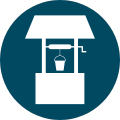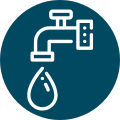
Our vision:
A safe and healthy Kitsap County for all.
Residential Building Clearances
Drinking Water & Onsite Sewage
You need a Residential Building Clearance (Residential or Commercial) from the Health District if:
You have an existing septic system and your construction project requires Health District approval in order to get your building permit.
You may also need a Connection Permit from the Health District if:
Your project includes a new connection to your septic system or
Your project includes disconnecting a structure from your septic system and connecting a new structure to your septic system. (For example: replacing a manufactured home with a new manufactured home.)
Have questions? We're here to help! Call us at 360-728-2235.
What You Need to Know About Properties Connected to a Septic System
A septic system is a critical part of a home. It collects, treats, and disposes of all water from toilets, sinks, tubs, showers, dishwashers, and other appliances.
Before buying or selling a home connected to a septic tank, make sure that you know the status of the septic system. Kitsap Public Health District can review records, inspect the system, and provide you with a written report of what we find. This is a great way to help protect your investment and follow regulations (Kitsap Public Health Board Ordinance 2008A-01, Section 13.D).
Before the final sale of a property, contact us for a property conveyance inspection (PCI) to identify any significant problems. Without an inspection, potential problems are not corrected and can cause major problems later on. For instance, a septic system my fail after new owners purchase a home, costing them thousands of additional dollars in repairs.
For us to perform a property conveyance inspection, we will need a record drawing. If your property does not have one, you will need to create one.
2024 Property Conveyance Inspection Findings
1,676 property conveyance inspections for septic were completed in 2024. Of those, 464 (28%) had significant deficiencies identified.
Avoiding Common Problems on Property Conveyance Inspections


Encroachment
Don’t build or park on your primary or reserve drainfield. Primary and reserve drainfield areas are intended to be maintained clear for maintenance and for future use.
Maintenance accessibility
For alternative systems, keep components accessible for maintenance.
Using beyond capacity or having unpermitted connections
Stay within the designed capacity of your drainfield design. To find out how many bedrooms your septic is approved for, search for your records through our GIS Search.
Do not add plumbing to outbuildings without project review and approval from Kitsap Health.
Compromised primary or reserve areas
Know where your septic areas are and protect them. To learn more about protecting those areas, review the Homeowner’s Guide
What You Need To Know About Properties Connected to a 1- or 2-party well or a Group B Water System
Effective March 4, 2019, all properties served by a Private or Group B Water System are required to have a Water Status Report from the Health District bfore they are sold.
Water Status Report applications (public and private) should be submitted 30 days before the property transfer to allow for any identified issues to be addressed before closing sale.
For more information, read our Private Water Status Report Frequently Asked Questions handout.
Just like a property conveyance inspection is important to know the status of a septic system, it is also important to evaluate your water system to identify significant problems.
2024 Private Water Status Report Findings
438 private water status reports were completed in 2024. Of those reports, 173 (39%) had significant problems identified.
Avoiding Common Problems on Private Water Status Reports
Construction Standards
Keep your well-head above grade and accessible (at least six inches above grade)


Well openings/access for contamination
Openings in the well casing/cap can allow contamination into the well. Ensure conduit, cap and all other entry points are sealed.
Ensure pressure tank maintenance is up to date and sample for bacteria annually. For more information about bacteria sampling, view our handout.

2024 Group B Water Status Report Findings
124 public water status reports for Group B systems were completed in 2024. Of those, 106 (84%) significant problems were identified.
Avoiding Common Problems on Public Water Status Reports
No user agreement
Group B user agreements have been required since 2019. All water systems should review their current user agreement or, if there isn’t one, create one. Learn more:
No operating permit
Group B water systems must have a current operating permit. Ensure water system contact information is up to date and the permits have been paid. For more information, visit our Group B Public Water Systems page.
No current samples
Most Group B water systems must sample annually for bacteria and every three years for nitrate. If you’re unsure of your sampling frequency or need technical assistance with taking samples, please call us at 360-728-2235 and ask to speak to the Drinking Water Inspector of the Day.
Reminder cards are mailed approximately 30 days prior to sample due date. Please make sure your system contact information is up to date.
Residential Building Clearance Requirements
Permitted septic system and reserve
You must have a permitted septic system and a designated reserve area to qualify for a Building Clearance.
A reserve area is an area of your property set aside to accommodate a new septic drainfield in the event that your existing drainfield fails. You can check your septic records online.
If your septic system is not permitted, you do not qualify for a Building Clearance and will have to go through a different process to get your Health District approval to obtain your building permit. Call the Health District for details: 360-728-2235
If your septic system is permitted, but you do not have a designated reserve area, call the Health District for guidance before applying for a Building Clearance. We will check your property records and direct you to an inspector who can explain your options.
Building Clearance Application
You can apply online; or you can fill out a paper application and submit it to the Health District. You can send the application by mail, but we recommend you submit it in-person so we can give your proposal a preliminary review.
Site plan
The Health District requires a scaled site plan. Review our site plan requirements to make sure you meet all of the criteria.
Read the requirements carefully. The most common reason for delay is an incomplete or inaccurate site plan. Be sure to use your As-built or Record of Construction drawing to reference the septic components.
If you apply online, please attach a PDF of your scaled site plan.
If you apply in person, please bring a copy of your scaled site plan.
Up-to-date septic system inspections
If you have an alternative septic system with a maintenance contract, a current report should already be available.
If you have a standard gravity septic system, the Health District will check to see if you have a current pump report (within the last three years).
You can check the status of your septic maintenance/pump reports status online.
Drinking water compliance
All proposals require that public water systems must be in full compliance with regulations. Private water supplies must be in compliance with WAC 173-160.
Some proposals also require full water adequacy for private wells. (For example: replacing an existing residence, adding a bedroom, or building an accessory dwelling unit (ADU) or guest house.)
Septic System Connection Permit
If your project involves connecting a new structure to your septic system or replacing a structure (for example, replacing a mobile home with another mobile home), you need a Septic System Connection Permit.
How to Apply:
Online Application
Fill out the online application and sign the permit form.
Attach the signed form to your online application.
Pay with a credit card.
In-Person or Mail Application
Pay by check (if mailing), or cash/card (if in-person).
Inspection & Final Steps:
After purchasing your permit, you may connect your structure to the septic system, but do not cover the connection until the Health District inspects it.
Complete a Record of Construction: (This document will become part of your property records.)
Use Record of Construction for Connection for basic connections.
Use Record of Construction for Component if a new component (e.g., pump tank) was added.
Inspections are completed within 2 business days.
The inspector will inform you of any corrections or approval to cover the connection.
IMPORTANT: Leave the connection uncovered until approved by the Health District. The Building Permit Final cannot be issued until the connection is inspected and approved.
How to Avoid Delays
The most common reasons for delayed review or approval are:
Incomplete or inaccurate site plans. Read the site plan requirements carefully. In your records you should find:
Septic design (including property shape and dimensions)
As-Built or Record of Construction that shows how your septic system was installed
Entering the wrong person as the applicant.
Submitting the Building Clearance before the required septic tank pumping has been completed.
Forgetting to notify the Health District that the septic connection is ready for inspection.
When you make the new connection to your septic system, leave the connection exposed for inspection.
You can notify the Health District that your connection is ready for inspection online.
Submitted requests will be inspected within three business days.










.png)
